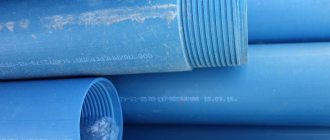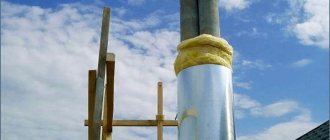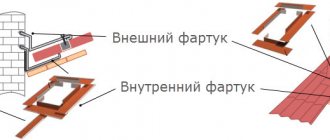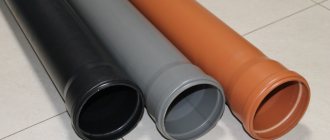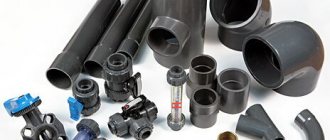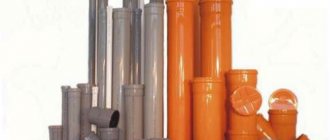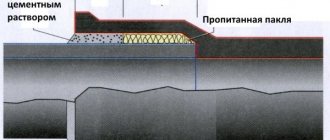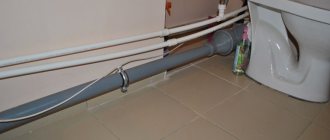It’s no longer a secret that PVC-U casing pipes have proven themselves to be the best when drilling water wells. Today there is simply no alternative to them. As they say: “demand creates supply,” and more and more drilling companies are switching to drilling with innovative uPVC pipes. Accordingly, market competition appears and the cost of a meter of drilling with these pipes varies from company to company. Let's figure out why?
The first production of these pipes was established in 1998 by a group in Yaroslavl (Yartruba). In 2005, the company was awarded a gold medal “For the development and production of PVC-U casing pipes for wells . The quality of the products is confirmed by the assessment of the enterprise according to the international certification “Quality System ISO 9001:2008 ”
Twenty years have passed. During this time, other manufacturers of uPVC pipes appeared, whose products are much cheaper, but the quality leaves much to be desired.
This is the first thing - the price per meter of drilling depends on the casing pipe manufacturer.
Today, the most common design of water wells is with PVC-U casing pipes with a diameter of 125 mm, which, depending on the series, have different wall thicknesses of 5 mm, 6 mm and 7.5 mm. For example, a pipe with a wall thickness of 6 mm can withstand a load of 8 atmospheres, and with a wall thickness of 7.5 mm can withstand a load of 16 atmospheres (1 atmosphere = 10 meters of water column). Most drilling companies do not indicate the wall thickness of the pipes, limiting themselves only to a pipe diameter of 125 mm and when drilling wells they use a pipe with a wall thickness of 5 mm, relying on “Russian maybe...” .
This is the second thing - the cost of a meter of drilling depends on the series of uPVC pipes.
More “cunning” drilling companies, in order to reduce the cost of a well and get the greatest profit, combine pipes with different wall thicknesses. For example, pipes with a wall thickness of 6 mm are installed at the bottom of a drilled shaft, then pipes with a wall thickness of 5 mm are installed, etc.
This is the third thing - the cost of a meter of drilling depends on the design of the well.
In some cases, the “top” of the drilled limestone horizon comes with interlayering of marl (limestone clay) and so that the water does not stain along the path of its movement, it is necessary to install PVC-U pipes with a diameter of 90 mm (in a countertop) in this interval. Also, an additional column with a diameter of 90 mm must be installed if the static level in the well is low and the centrifugal pump will be installed in the limestone zone. Enterprising drilling companies present the client with a fait accompli and demand that they pay 300 or 400 rubles per meter in addition to the cost of the well. In most cases, this column is placed where it is not required, “hanging noodles on the client’s ears” - this is the fourth.
CONCLUSION.
Analyzing the market for water well drilling services, our company’s specialists called drilling companies under the guise of a client, both drilling companies that work with innovative uPVC pipes, and drilling companies that do not work with these pipes. What kind of nonsense have we heard? And that “UPVC pipes will crush moving formations”, and that “the drilling tool will break them” - this is usually said by “specialists” of drilling companies who do not work with UPVC pipes because they don’t know how, since they have drilling specialists on their staff with low qualifications.
And the “specialists” of drilling companies that work with these pipes only name the price per meter of drilling a well, deliberately hiding the manufacturer of the pipes, the series of these pipes, and the design of the well.
Dear Clients! If you want to know how the load on pipes is calculated in order to choose the right wall thickness of uPVC pipes, get detailed advice on which well design to choose, find out the exact cost of the well and get professional and competent answers to your questions, then call the AQUAGEOCOMPLEX drilling company.
Which casing material is better?
Casing pipes for well development are pipes whose diameter is regulated by SNIP and should be either 33.5-89 mm or 108-146 mm. Moreover, for each diameter there is also a so-called non-straightness in the permissible standards. So, with a diameter of 33.5-89 mm, the permissible rate of pipe curvature is 0.7 mm per 1 linear meter, and with a diameter of 108-146 mm, the level of non-straightness should not exceed 1 mm per meter of element.
The materials used for casing pipes in the modern geological industry are steel, cast iron, asbestos cement or plastic. In this case, it is better to use PVC casing pipes, since they are in advantage today. Plastic has a number of positive characteristics:
- Thus, plastic pipes for water can withstand a high level of compression load of up to 5 tons. Therefore, the risk of shifting a section of the casing under the influence of the movement of soil layers is minimal, regardless of the size of the pipe.
- The service life of PVC casing is about 50 years, which is equivalent to the service life of an artesian well. That is, you will not have to start repairing the casing throughout the entire life of the source.
- Casing pipes for wells made of plastic, unlike steel ones, are not subject to corrosion under the influence of water. This means they will not fail and leak groundwater.
- The inner side of the PVC column has a smooth surface, which facilitates the flow of water through the wellbore and makes it better. And this, in turn, makes it possible to use smaller pipes (diameter) for shaft casing.
- In addition, plastic pipes have less weight, which allows saving on labor costs when installing well casing.
At the same time, for casing the well with plastic elements, you can use a water-lifting shaft made of the following materials:
- Polypropylene;
- Polyvinyl chloride (uPVC)
- Polyethylene (HDPE).
Each type of selected pipe is mounted in depth using threads.
Important: in addition to the listed advantages, we note that the walls of plastic pipes are not subject to the accumulation of growths on them.
Construction of an Abyssinian well
The needle well design was developed a long time ago, about 150 years ago. The source of water intake was not fundamentally modified during this time. Only the filter was subject to modernization. The well has a fairly simple structure, which allows you to make it yourself and quite quickly.
The needle well consists of the following parts:
- Drilling rig;
- Koper;
- Filter.
The projectile consists of a tip and a barrel. It is assembled from several pipes. It serves as a channel through which water rises. The Koper includes a metal tripod and a weighty woman in its structure. This element acts as a hammer. The filter plays an important role. Its production takes a short period of time, but it is important to do the work carefully. You need to measure the length of the sump, then lay the pipe horizontally and mark it.
The perforated section should be no more than 25% of the entire length of the pipe and pass only in the water intake part of the well.
It is quite cheap to build an Abyssinian well.
The holes are drilled in a checkerboard pattern at an angle of 30 degrees. Perforation is carried out in the direction from top to bottom. In this case, you need to indent from the edge of the pipe at least 1 meter. The interval between holes should be about 10-20 mm. Having made the perforation, you need to clean it and remove the chips, and close its lower part with a sealed lid or plug. To prevent fine gravel and sand from getting into the water, you need to put a mesh over the filter. It will help avoid clogging.
Steel column
If you decide to use steel pipes of the required diameter for casing the column, please note that they are also mounted deep by connecting threads. However, the use of steel elements is not as practical as the use of a water-lifting pipeline made of HDPE or uPVC, namely:
- Steel is susceptible to corrosion over time, no matter what the alloy.
- The weight of the steel water-lifting pipeline is quite large, which means that heavy equipment will have to be used to casing the column onto the water.
- In this case, steel pipes will contribute to a high iron content in well water. In addition to arranging the source, additional filters will be required.
- In addition, a steel water intake shaft will enhance the metallic taste of the water.
Asbestos cement column
The use of such pipes is gradually disappearing in geology. Since the use of a water-lifting column made of asbestos-cement is only relevant on hard soil layers. In addition, the connection of such pipes to water is carried out using couplings, not threads, which complicates the process of casing the well string. In addition, it is necessary to carefully monitor the tightness of the joints and carry out the work carefully, since asbestos-cement pipes for wells, unlike steel, uPVC and HDPE, are characterized by increased fragility.
What to do if you don’t have professional equipment
When hit with a sledgehammer, the pipe inevitably moves in one of the directions, and may even bend itself.
The only professional equipment that is difficult to do without when constructing an Abyssinian well is the headstock. However, there is also a possible way out - clogging the pipe with a sledgehammer. The only caveat is that you will have to constantly monitor the vertical position of the well body.
Another option for driving pipes without using a headstock is a reinforcing rod of sufficient length and weight. Its diameter should be less than the diameter of the pipes used. In this case, the impact load falls on the needle tip itself, and the threaded connections and pipes do not experience heavy loads. There is only one risk - this very tip will be torn off, which will entail the need to remove the entire structure and carry out repair work.
Column casing principle
When drilling a well, it is necessary to equip the mine with casing pipes. This is done in several stages in order to securely fasten the lowered pipes in the barrel of the drilled well. In this case, both uPVC casing elements and HDPE pipes must be lowered into the source shaft exclusively during drilling.
Rules for casing installation
When installing the casing, do not forget to follow the recommendations of professionals, namely:
- The edge of the lower casing pipe made of uPVC, HDPE or steel should not reach the bottom by approximately 50 cm. This will ensure the free flow of water into the mine in all weather conditions.
- You should not reduce the diameter of the casing as you go down. This will help reduce the flow of water.
- Before installing the HDPE or uPVC column, as well as steel, the thread must be checked and treated with silicone sealant.
It is important to remember: the well casing is carried out as the source deepens. At each stage of the drill’s operation, it is necessary to lower PVC-U, HDPE or steel pipes into the shaft, reliably connecting the threads. After installing the column, the annulus should be cemented so that the column stands monolithically and is not affected by the movement of rock layers.
Design and construction of an autonomous water supply and sanitation system is a task that takes a lot of time, physical effort and financial costs. At the stage of mine development, the choice and installation of casing plays a great role. A well without a casing is characterized by a short service life, low quality of produced water, and there is no reinforcement of the walls of the structure, which threatens collapses.
Possible mistakes and tips on how to avoid them
The use of low-grade cement can cause destruction of piles . To prepare concrete, you need to use cement M 400–500.
Deviation from the vertical wells is a consequence of drilling “by eye”. When drilling wells, you must always use a plumb bob or laser level.
The foundation is not poured when the air temperature is below freezing - this leads to the destruction of the monolith. The piles are concreted with minimal air heating of 5–10 C.
Important and useful information about the pipes used to make piles for the construction of a pile foundation is in this section.
Purpose and scope of casing pipe for a well
First of all, you need to decide what a casing pipe is and for what purpose it is used. This is a special column equipped with a reinforced casing, the main task of which is to strengthen the internal structure of the hydraulic structure. As a rule, more than one functional element is installed in a deep well shaft. They are connected to each other, and the seams are treated with sealant to obtain a single casing.
The thickness of the walls of the casing rings should be determined by the type and characteristic features of the structure, as well as the material used to manufacture the column walls.
Products made of concrete and metal are characterized by large wall thickness, diameter and length, in comparison with parts made of plastic. To create a tight connection between the elements, the end of one pipe always has a coupling. The second end is equipped with a ring that protects the thread from damage.
Source casings are required to perform the following tasks:
- Protect the water pump or pumping system installed in the shaft from possible contamination and mechanical damage.
- Ensure the integrity of the water intake point throughout its entire service life. The products are characterized by increased strength, resistance to deformation and damage.
- Protect the well from high soil pressure.
- Prevent the seepage of sewage or groundwater into the well, which threatens to pollute the water and infect it with pathogens.
It is necessary to give preference to the threaded connection method, otherwise it is almost impossible to achieve reliable sealing of the casing pipes.
How to build it yourself?
This instruction is advisory in nature and is not a direct indication of the exact implementation of its points. It reflects the basic rules for constructing a pile foundation from PVC sewer pipes - these are:
- Preparing the construction site.
- Procurement of building materials and selection of tools.
- Drilling and preparation of wells.
- Installation of pipes.
- Reinforcement of piles.
- Preparation and pouring of concrete.
- Backfilling of wells.
Construction site preparation
Debris is removed from the construction site and the fertile layer of soil along with vegetation is removed. Use a cord and pegs to mark the location of the centers of the piles. The correct construction of marking rectangles is checked by the equality of the diagonals between opposite corners.
Procurement of building materials and selection of tools
You will need the following materials:
- PVC sewer pipes;
- crushed stone, sand, cement and water;
- periodic profile reinforcement ø 8 – 10 mm;
- smooth reinforcement ø6 mm;
- knitting wire.
To carry out the construction process you will need the following tools:
- bayonet and shovel shovels;
- wheelbarrow;
- garden auger;
- laser level;
- concrete mixer or container for mixing the solution manually;
- hacksaw, construction knife;
- buckets.
Drilling and preparation of wells
Before drilling the soil, the drill axis is set strictly vertically . During the drilling process, the verticality of the tool is strictly controlled.
In case of distortion, the installed pipe will lose part of its load-bearing capacity. The bottom of the well should be 200 - 300 mm below the design mark of the bottom of the pile. This is necessary to widen the base of the foundation.
It is not necessary to expand the supporting area of the pile. However, if there are doubts about the insufficient load-bearing capacity of the supports, then the bottom of the well is expanded with a special device.
It consists of an axis with a movable blade attached to it with a cutting blade and a storage hopper. Using a cable, the blade is gradually raised from below to the horizon, cutting off the soil in a circle of rotation of the device. The mining goes into a hopper, which is then removed along with the blade to the top.
Sand is poured onto the bottom and compacted thoroughly . The excavation is filled with concrete and the well is left alone for 14 days.
Pipe installation
To avoid distortions, wells are drilled 50 - 70 mm larger than the diameter of the pipes. This makes it possible to adjust the vertical of the pile and fix its position with spacers made of timber.
Reinforcement
One or several reinforcing rods of a periodic profile connected by wire with transverse smooth reinforcement are lowered vertically inside the supports. To connect the piles to the grillage, reinforcement outlets are left to a height of 200–300 mm .
Preparation and pouring of concrete
The pipes are filled with concrete M 300. For its preparation I use cement M 400–500.
Cement, sand and crushed stone are poured into a concrete mixer. As the drum rotates, water is gradually added to it until a thick liquid solution is obtained.
The solution is loaded into a wheelbarrow and taken to the next pipe. Concrete is poured into buckets, constantly tamping it with improvised rods .
Backfilling of wells
After pouring is completed, the cavities around the piles are filled with soil or a sand-gravel mixture. The backfill is compacted layer by layer. After 30 days, installation of the grillage begins.
Installation features
Installation of casing parts is carried out by drilling the soil with a drill. The diameter of the drill must be less than the diameter of the casing. Then it is taken out of the ground and the contaminants are removed. The casing is lowered when the well depth reaches 2 meters. Further drilling should be carried out together with casing until the aquifer is reached.
The classic version of the casing looks like this:
- The filter for coarse purification of well water is a wire or stainless mesh.
- A bottom filter made from gravel. Protects water from contaminants that can penetrate into the source from greater depths.
- A sealed head that prevents contamination from entering the well shaft from the outside. Its fastening is accompanied by the formation of negative pressure, which leads to an increased influx of water. To increase the negative pressure, the head is cemented.
When choosing a suitable casing for a well, they are guided by a simple but proven combination of quality and price. These parameters determine how long the structure will operate.
It is recommended to design deep wells with metal products equipped with external and internal threads. If the depth of the well shaft is less than 50 meters, preference is given to a budget alternative - plastic pipes. Asbestos-cement products are installed at a well depth of no more than 15 meters, otherwise the material may not withstand the pressure exerted by the soil layers.
Difficulties to be faced
The very first difficulty is getting to the layer in the soil where the water is. Since the thickness of the earth can be either minimal - 3-5 meters, or reach 10-15 meters. Therefore, in order to reduce drilling costs, it is necessary to conduct geological exploration (there are cases when the drilling depth in different places with a distance of 3 meters from each other reaches 7-10 meters). However, once you get to the water, the next problem arises. Soil of any density will crumble into the formed well, since water under pressure will rise to the top and wash it away. To avoid this situation, be sure to use a casing pipe into which a pipe of smaller diameter is inserted. The second pipe is called the service pipe, which is often plastic.

